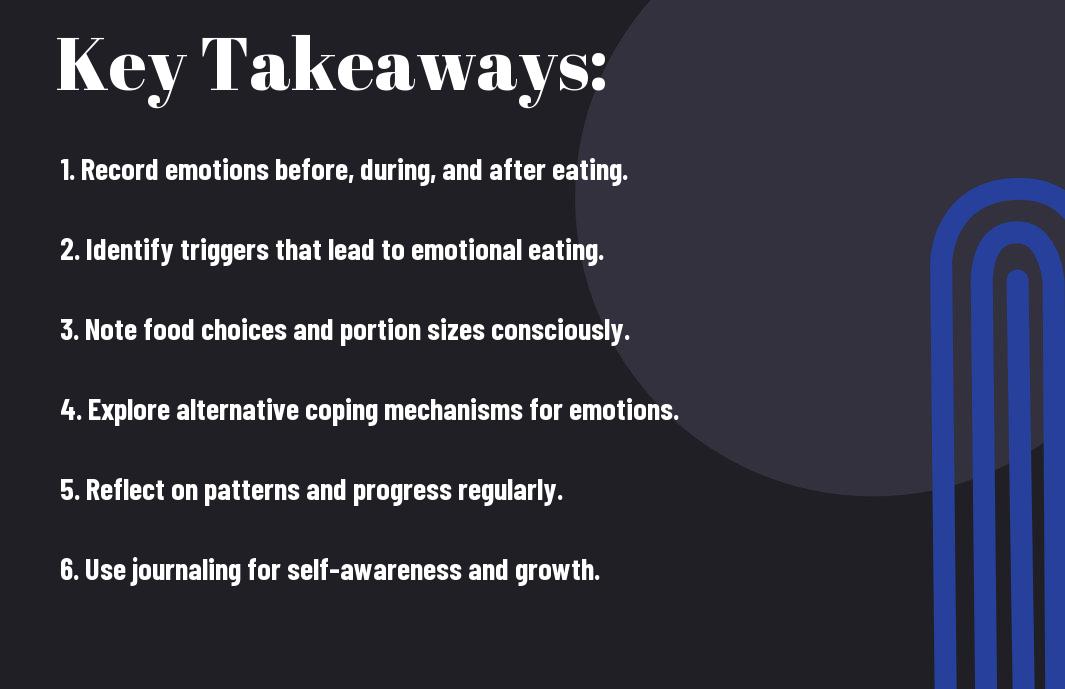Emotional connections to food can often disrupt your relationship with eating, leading to patterns that are hard to break. By creating an emotional eating journal, you can gain valuable insights into the triggers and emotions that drive your eating habits. This tool not only helps you track your feelings and food choices but also empowers you to make mindful decisions about your health. In this post, you’ll discover practical steps to set up your journal and use it effectively to enhance your emotional well-being.
Key Takeaways:
- Self-Reflection: An emotional eating journal encourages personal insights into eating habits and emotions.
- Triggers Awareness: Documenting feelings can help identify specific triggers that lead to emotional eating.
- Food Choices: Record what you eat along with emotions to gain understanding of patterns in food choices.
- Mindful Eating: Promotes mindfulness by fostering awareness of the reasons behind food consumption.
- Goal Setting: Helps in setting and tracking goals related to emotional health and eating behaviors.
- Progress Tracking: Enables reflection on progress over time, providing motivation and encouragement.
- Support Resource: Can serve as a valuable tool to share with nutritionists or therapists for tailored guidance.
Understanding Emotional Eating
A deeper exploration of emotional eating allows you to grasp the intricate relationship between your emotions and eating habits. It involves recognizing how feelings can influence your food choices, leading you to eat in response to stress, sadness, or even joy, rather than hunger. Understanding this connection is key to making lasting changes to your eating behaviors.
Definition and Causes
Eating in response to emotions rather than physical hunger is known as emotional eating. It often arises from various emotional triggers, such as stress, anxiety, sadness, or boredom. You may find yourself reaching for comfort foods as a way to cope with these feelings, which can lead to a cycle of guilt and further emotional distress.
The Connection Between Emotions and Food
Behind every bite you take in response to emotions lies a complex landscape of feelings. Food can serve as a temporary escape, providing comfort or a sense of control when life feels overwhelming. You might find yourself gravitating towards high-calorie, sugar-laden foods that provide immediate pleasure but do little to address the underlying emotional issues.
Hence, acknowledging this connection is vital for understanding your emotional eating patterns. You may notice that certain emotions trigger specific cravings, leading you to unconsciously associate food with relief or happiness. By recognizing these emotional triggers, you gain valuable insight into your eating habits, paving the way for healthier coping strategies and choices that honor both your emotional and physical wellbeing.


The Importance of a Journal
There’s a profound significance in maintaining an emotional eating journal. It serves as a safe space for you to express your thoughts and feelings, allowing for reflection and insight. By documenting your experiences, you can better understand the connection between your emotions and food choices, leading to healthier habits and improved emotional wellbeing.
Tracking Emotional Triggers
Any time you feel the urge to eat, jot down what triggered the emotion. This practice helps you identify situations that lead to emotional eating, whether they stem from stress, boredom, or anxiety. By pinpointing these triggers, you can begin to explore healthier coping mechanisms that don’t involve food.
Recognizing Patterns in Eating Habits
Any consistent journaling practice allows you to identify patterns in your eating habits. You may notice certain emotions or situations that repeatedly lead you to food for comfort. Understanding these patterns is vital in making conscious choices about your eating, ultimately empowering you to break the cycle.
Habits can often go unnoticed until you take the time to examine them closely. By analyzing your journal entries, you may discover that specific feelings or situations frequently lead to emotional eating. Identifying these recurring patterns enables you to implement preventative strategies and alternative responses, helping you cultivate a healthier relationship with food and your emotions.
How to Create an Emotional Eating Journal
To create an effective emotional eating journal, begin by establishing a dedicated time and place for your reflections. This can help you cultivate a habit of documenting your experiences around food and emotions. For more insights, you can explore Emotional Eating and How to Stop It. Regular entries can enhance your understanding and promote positive changes in your relationship with food.
Choosing the Right Format
Along with selecting a medium that allows you to express yourself freely, consider whether you prefer a digital app, a handwritten notebook, or even voice memos. The best format is one that feels comfortable to you and encourages consistent entries. Assess what resonates with your style, as this will make it easier for you to engage with your journal regularly.
Key Elements to Include
Right from the start, be intentional about including specific elements in your emotional eating journal. Capture relevant details, such as the date and time of your eating episode, the food consumed, the emotions you were feeling, and any triggers that influenced your choices. This structured approach can help you recognize patterns over time.
A comprehensive journal not only tracks the foods you eat but also investigates into the emotions and situations that surround your eating habits. You may want to note your hunger levels, the setting in which you ate, and whether you ate mindfully or mindlessly. Tracking these elements can lead to valuable insights, empowering you to make healthier choices and develop strategies for addressing emotional triggers. Over time, this reflective practice can significantly enhance your awareness and self-management around emotional eating.

Tips for Consistency
Now that you’re ready to start your emotional eating journal, consistency is key for meaningful insights. To help you stay on track, consider these tips:
- Schedule a specific time each day for journaling.
- Keep your journal accessible to encourage regular entries.
- Set reminders on your phone or calendar.
- Consider incorporating the journal into your routine after meals.
Recognizing the impact of your emotions on your eating habits can enhance your journey. For more insights, check out Food & Feelings.
Setting a Routine
About establishing a routine for your emotional eating journal, consistency can be greatly improved by integrating this practice into your daily life. Choose a specific time and place where you feel comfortable reflecting on your feelings and food choices. This could be after meals or at the end of your day, whichever works best for you.
Overcoming Common Challenges
Below are some challenges you may face, and how to overcome them effectively. Starting a new habit can sometimes be daunting, especially if you’re unsure of what to write or find it hard to be honest with yourself. You might feel overwhelmed by emotions or distracted by a busy schedule, which can hinder your journaling efforts.
The key is to approach these obstacles with patience and flexibility. For uncertainty about what to write, consider using prompts or questions to guide your entries. If emotions feel overwhelming, allow yourself to express them without judgment, focusing on simple phrases. Moreover, integrate journaling into established routines, like right after meals or as part of your evening wind-down. This will help you maintain momentum and regularly engage with your emotional eating patterns.

Analyzing Your Entries
Not all emotional eating occurs sporadically; by analyzing your journal entries, you can uncover underlying patterns. This process involves reflection on the circumstances surrounding your eating habits and can lead to meaningful insights. For additional guidance, check out Binge-eating: Tips for writing an emotional food diary.
Identifying Trends
The key to understanding your emotional eating lies in identifying trends within your entries. Look for common triggers, emotions, or situations that lead to overeating. By recognizing these patterns, you can start connecting how your mood affects your eating choices and vice versa.
Making Informed Adjustments
Behind every tendency to turn to food during emotional moments, there may exist deeper issues that need addressing. By evaluating your entries, you can start making informed adjustments in your daily routines and emotional coping strategies. This self-awareness lets you tackle the root causes instead of merely reacting to them.
In fact, once you begin to understand the glitches in your eating patterns, you can explore healthier alternatives for managing your emotions. Consider implementing mindfulness practices, seeking support from friends, or even consulting a professional. Adjusting your food choices and coping mechanisms can lead to healthier behaviors that promote emotional well-being and overall health.
Seeking Support
Your journey toward understanding and managing emotional eating can be greatly enhanced by seeking support. Connecting with friends, family, or support groups allows you to share experiences, gain insights, and feel less isolated. Building a network of understanding individuals can motivate you to stay committed to your journaling practice and help you develop healthier coping mechanisms when faced with emotional triggers.
When to Involve Professionals
The decision to involve professionals often arises when you notice persistent patterns of emotional eating that interfere with your daily life. If you feel overwhelmed, anxious, or unable to control your eating habits despite your efforts, consulting a therapist or nutritionist can provide valuable guidance. They can offer tailored strategies and support that address not only the behavior itself but also the underlying emotions driving it.
Community Resources
When looking for additional support, consider exploring community resources tailored to emotional health and nutrition. Local support groups, workshops, and counseling services can offer an avenue for connecting with others who share similar experiences.
A variety of community resources are available to help you navigate your emotional eating journey. Many organizations host support groups, providing a safe space for you to share struggles and successes. Additionally, workshops often focus on topics such as mindfulness, stress management, and healthy eating habits. Many communities also offer access to registered dietitians who can work with you individually to develop practical strategies, all of which can complement your emotional eating journal and further your progress.
Final Words
Drawing together your experiences through an emotional eating journal can significantly enhance your self-awareness and emotional intelligence. By consistently documenting your food choices alongside your feelings and triggers, you empower yourself to identify patterns and make informed decisions. This process not only aids in understanding the relationship between your emotions and eating habits but also encourages healthier coping mechanisms. As you continue this journey, you’ll likely find greater clarity and control over your emotional eating, paving the way for a more balanced approach to food and wellness in your life.
FAQ: Creating an Emotional Eating Journal
Q: What is an emotional eating journal?
A: An emotional eating journal is a tool that helps individuals track their eating behaviors in relation to their emotions. By writing down what you eat, how you feel before and after meals, and any triggers you notice, you can gain a better understanding of your eating patterns and emotional connections to food.
Q: How do I start an emotional eating journal?
A: To begin, choose a format that suits you, such as a notebook, an app, or a digital document. Then, set aside time daily to record your meals, feelings, and any circumstances surrounding your eating. Be honest and detailed about your experiences to facilitate effective reflection.
Q: What should I include in my entries?
A: Your entries should include details such as the time of eating, the food consumed, the emotions you felt at that moment, any triggers (like stress or boredom), and how you felt afterward. This comprehensive approach will help you identify patterns over time.
Q: How can an emotional eating journal help me?
A: Keeping an emotional eating journal can provide insights into your relationship with food. It can help identify emotional triggers that lead to overeating and promote mindfulness in your eating habits, ultimately aiding in developing healthier coping mechanisms.
Q: How often should I write in my journal?
A: Aim to write in your journal daily or at least several times a week. Consistency will enhance the effectiveness of your journal, allowing you to gather enough data to identify patterns and triggers accurately.
Q: What if I struggle to identify my emotions?
A: It’s common to have difficulty pinpointing emotions. Consider using prompts or lists of feelings to help. Additionally, take your time with your entries; you can write about your thoughts and experiences as they come to you and gradually refine your understanding of your emotions.
Q: How can I stay motivated to maintain my emotional eating journal?
A: To maintain motivation, set specific goals such as tracking your entries for a month or reviewing them weekly. Celebrate small achievements and reflect on what you learn through this process. Connecting with a supportive community or a friend can also keep you engaged and accountable.





